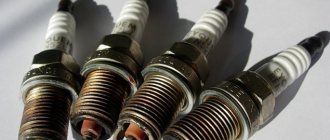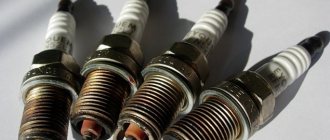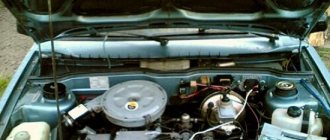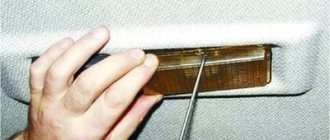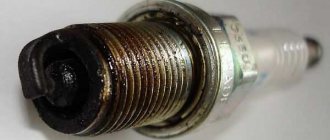Quite often, when operating an injection or carburetor car, you may encounter that the engine jerks during acceleration. In other words, after sharply pressing the gas pedal, there is no clear response from the power unit, a pause-failure occurs, the speed increases in jerks, etc.
These jerks are a rapid change in the crankshaft speed, regardless of the position of the gas pedal and the degree of pressure on the accelerator. As a rule, such jerks follow in series, causing the engine to jerk.
As for failure, that is, when the engine “stubs” during acceleration, there is a noticeable delay in the reactions of the internal combustion engine after the driver sharply presses the gas to increase the speed. Moreover, in both cases, when you smoothly press the gas pedal, the speed increases without jerks or delays, that is, quite predictably.
It is quite obvious that operating a vehicle with such faults is not only difficult, but also dangerous. While driving, there is no opportunity to overtake, quickly change lanes, etc. To solve the problem, the engine requires in-depth diagnostics, since it is first necessary to clearly determine the cause of the breakdown.
Next, we will talk about why an injection engine or carburetor engine jerks during acceleration, as well as what methods can be used to identify and fix problems that have arisen.
When does this happen
Almost every car enthusiast who has logged more than tens of thousands of kilometers has encountered such a problem as uneven driving of the car, or, in popular parlance, the car simply jerks in some operating modes.
The car jerking can be as follows:
- the beginning of the movement;
- at low speeds;
- with increasing speed;
- at high speeds;
- in all modes at once.
Moreover, it is worth noting that such a malfunction occurs not only on an old car; a new car is also capable of twitching.
It is impossible to say that the cause of uneven running is only a certain part of the car and that it is unique to a specific brand of car.
Based on reviews from car owners, we can conclude that this problem occurs with absolutely any vehicle - an old VAZ “Seven” or a new “Japanese”.
The appearance of uneven movement of the car not only irritates the driver, but can also cause an accident, because at the right moment the car, instead of accelerating, will begin to twitch.
Let's try to figure out in detail what can cause the car to jerk while moving. But to do this, you first need to understand how everything happens.
Quick diagnostics
So, the car is started, the speed is turned on, the clutch is slowly released, and the engine speed gradually increases.
But instead of smoothly starting from a stop and starting to pick up speed, the car begins to jerk - the speed fluctuates, the speed either increases or drops sharply, despite pressing the accelerator pedal.
This can continue until either the twitching goes away on its own and the car begins to confidently gain momentum, or until the engine stalls.
It happens that the car starts moving quite safely, but as soon as the revolutions increase to 2000-2500, uneven movement begins, accompanied by sharp changes in engine operation, as well as in the speed of movement.
The same situation can be observed when reaching medium modes, that is, the engine reaches a certain speed level, after which twitching begins.
It happens that the car starts to jerk every time you change gears.
It is not necessary that uneven running occurs only under certain conditions.
It also happens that the car jerks spontaneously, without any frequency or conditions. That is, the car can jerk just once, in any mode, and then move normally for quite a long time.
Or the car was working normally, but suddenly began to twitch sharply, and this trouble no longer goes away.
In general, there are a lot of options, but one fact remains - the car has an uneven ride, and it is advisable to eliminate it as quickly as possible before the problem gets worse.
The first thing to do is determine under what conditions the twitching occurs. The easiest way to do this is while moving.
You should drive onto a flat section of the road where there is no traffic and start testing.
At first, just get moving, then gradually increase the speed, remembering the behavior of the car and watching the dashboard.
And this must be done until the engine reaches high speeds.
Afterwards, you will need to run the test again to make sure that the conditions for the appearance of twitching are determined correctly. And only after that you can start looking for the reason.
A summary table of the reasons why the car jerks for different types of motors for quick diagnosis.
| Causes | Car jerking while driving | |||
| Injector | Carburetor | On gas | Diesel | |
| The carburetor is clogged or faulty (clean, repair, replace) | — | + | — | — |
| Fuel and air filters are clogged (replace) | + | + | + | + |
| Gas filter clogged (replace) | — | — | + | — |
| Dirty injectors (clean, replace) | + | — | + | + |
| Malfunctions in the ignition system (check for serviceability of spark plugs, ignition coil, high-voltage wires) | + | + | + | — |
| Excess air enters the intake manifold, which is not taken into account by the ECU (identify and eliminate air leaks) | + | + | + | + |
| The TPS or throttle actuator has failed*** Examine the symptoms of a malfunctioning throttle position sensor. | + | — | + | — |
| Malfunction of sensors responsible for engine speed: Idle air control, absolute pressure sensor, mass air flow, accelerator, coolant temperature sensor. | + | — | + | +* |
| The contact point of the crankshaft sensor (crankshaft sensor) has failed or become clogged. | + | -/+**** | + | +* |
| Fuel pump malfunction | + | + | — | — |
| Problems in the operation of the injection pump (high pressure fuel pump), life expired, breakdown | -/+** | — | -/+** | + |
| Problems with the gas reducer | — | — | +/-** | — |
| Freezing of the gearbox or lines | — | — | + | — |
| Clutch wear, incorrect adjustment | + | + | + | + |
| Transmission problems (manual transmission, automatic transmission, CVT, robot) | + | + | + | + |
| Problems in the operation of the elements of the cylinder-piston group (failure in valve adjustment or malfunction, breakdown of hydraulic compensators) | + | + | + | + |
| Fuel that does not meet the requirements of the car manufacturer, its low quality | + | + | + | + |
* applies only to diesel engines that have a Common Rail injection system.
** applies to vehicles equipped with direct injection engines and 6th generation LPG with liquid gas injection installed on them.
*** for cars with an injection system equipped with an electronic e-gas pedal.
**** for carburetors of cars with an electronic ignition system.
Identifying problems with the mixture
- Check the fuel rail pressure. In the case of low pressure in the ramp, the car jerks when driving under load and when trying to accelerate sharply. You can check the pressure through a special fitting or adapter, which allows you to connect across the fuel line. To measure pressure, you can purchase a special kit or make a device yourself. You only need a pressure gauge with a measurement scale of up to 7 kg/cm2, a hose, a tee, a female and male quick-release type.
- Check air leaks. The suction of unaccounted air manifests itself at idle, when the throttle valve is open less than 25-30%, as well as during a sudden release of gas. Under such conditions, the vacuum in the intake manifold of a naturally aspirated engine is greatest. The vacuum system is checked using a smoke generator. In addition to twitching during transient conditions, you may notice floating speed, shaking and unstable operation of the engine at low loads.
On cars with a carburetor power system, jerks during acceleration are most often associated with a malfunction of the accelerator pump or clogged filter elements. If the malfunction occurs when cold, check the circulation of coolant through the intake manifold, adjusting the quality and quantity.
Car jerking at low speeds
This problem often occurs when driving at low speeds at low engine speeds.
Checking the engine power system
Often the reason for the car twitching at low speeds is the power system, or rather, a malfunction in its operation.
When starting to move, the required amount of fuel simply does not enter the cylinders; the car is unable to produce the required power to evenly operate the transmission.
At the same time, transmission resistance leads to uneven running.
When jerking occurs at low speeds, first of all you should check all the elements related to the power system, and it makes no difference what kind of system it is - carburetor, injection or diesel.
It is recommended to immediately check the condition of all pipes. Depressurization of the system almost always leads to air being sucked in, which leads to fuel starvation of the engine.
And only after checking the condition of the pipelines can you proceed to the remaining elements of the system, which will be discussed below.
Ignition system
Also, the cause of jerking at low speeds can be the ignition system, especially for injection cars, where the entire operation of the system is controlled and regulated by an electronic unit.
A malfunction of one of the sensors can easily cause the machine to twitch.
What causes the machine to jerk when operating at low speeds?
The main systems in which problems often lie:
- Fuel supply system to the engine;
- Auto ignition system;
- Gearbox, both automatic and manual;
- Distributor;
- Fuel filter system;
- Sparking system;
- Car computer control unit.
If you hear the brakes squeaking when twitching, this may indicate the appearance of several, both interrelated and completely independent problems.
At high speeds
But the jerking of the car at high speeds is more related to the ignition system.
In a normally operating engine, the ignition system automatically adjusts to certain conditions by changing the ignition timing.
That is, when necessary, the ignition becomes either a little early or late.
A malfunction in the automatic ignition will cause twitching.
Do not forget that the cause of uneven movement will be not only a malfunction of the system, but also the failure of one of its elements.
And these are only the reasons that can arise with the engine, without affecting the transmission.
You need to immediately narrow the search for identifying the reasons for the car twitching to two engine systems - fuel and ignition, but you should not discount the transmission.
Is it due to the fuel filter?
So, it has been determined that the car jerks only under certain conditions. The fuel system pipes are all normal, but it is believed that the cause lies in the fuel system.
This means that the filters need to be checked next. Often it is because of them that this malfunction appears.
The task of any filter element in the fuel system is to clean the fuel from impurities, but at the same time, these impurities do not disappear anywhere, they remain in the filter itself.
Over time, it becomes so clogged with impurities and dirt that its throughput drops, and greatly.
As a result, the fuel pump pumps as expected, but the fuel does not have time to pass through the filter elements and the engine begins to “starve”, accompanied by the car jerking. There is only one way out here - .
Carburetor cars
If you take into account a carburetor car, then the number of filters it has is 2-3 pieces, but one of them, the usual mesh on the fuel receiver, can be practically discounted.
This mesh is aimed only at catching large particles, so it is practically incapable of becoming clogged to such an extent that it stops the flow of fuel in the required quantity.
But the second filter, usually located in the pipelines leading to the fuel pump, is worth checking.
This filter is designed to catch smaller particles and is not difficult to clog.
The third filter is not available on all carbureted vehicles and is usually located at the fuel inlet to the carburetor. It is also a regular mesh, but only fine.
This filter itself is small, so it often gets clogged.
Older machines had another filter installed - a coarse filter, also known as a sediment filter.
The design of this filter is such that it is not capable of becoming clogged to such an extent that it will not allow fuel to pass through. But this filter will subsequently cause rapid clogging of the fine filter.
If this filter accumulates a large amount of debris and dirt, then eventually it will not begin to clean the fuel from impurities, but, on the contrary, will begin to add them.
Injection car filters
Most modern injection cars are also equipped with three filters.
- The first of them is a mesh for catching large particles installed in the neck of the tank. This mesh is clearly not the cause of the twitching.
- The second filter is located on the fuel pump installed in the tank. This filter is also often a mesh, only with smaller cells; its task is to prevent large debris from entering the fuel pump. It is also unlikely that it can cause a lack of fuel.
But the third filter, a fine filter, is located behind the fuel pump and is quite capable of becoming clogged to such an extent that the pump cannot push the required amount of fuel through it.
On more modern cars, there may be additional filters, which can also cause the car to twitch.
Other elements of the fuel system
Now on to other elements of the fuel system.
Fuel pump.
The next culprit for uneven running may be the fuel pump.
In carburetor cars.
A mechanically driven diaphragm fuel pump is often used here.
So, even a small rupture of the membrane will cause the pump’s performance to drop sharply.
The pump valves may also be to blame. They can easily break the sealing of the device’s chambers, which leads to a drop in fuel supply.
Injection car.
The fuel pump can also cause jerking. On such cars, since the pump is located in the tank, it is electrically driven.
A decrease in device performance leads to the problem described in this article. Here you need to consider a specific case separately.
Now directly about the carburetor.
Because of this, uneven running of the car is also possible. Often such a malfunction occurs due to severe clogging. Debris and dirt can block channels, clog jets, etc.
Sometimes the reason lies in the accelerator pump. A diaphragm accelerator pump is installed on carburetors, the task of which is to increase the fuel supply when the gas pedal is sharply pressed.
But if the membrane is torn, then the accelerator pump will not be able to increase the supply of gasoline, and hence fuel starvation.
Injectors.
For injectors, the fuel injectors are checked next. Violation of their performance leads to jerking of the car.
Injectors need to be cleaned periodically, in principle, like everything else.
Also, in an injection car, the functionality of all sensors involved in the operation of the power system is checked, and then the electronic control unit is checked.
Let's go through the ignition system
The first thing that is checked in this system is the candles.
There have been cases when a car enthusiast replaced old spark plugs with new, and expensive ones at that, and ended up getting irritated due to the car jerking. But since the candles were new, he did not bother with them, but looked for a different reason.
This problem often occurs due to incompatibility of the spark plugs with the engine.
But their long-term use gives the same result. The spark plugs may fail, there will be gaps in their operation, and as a result, the fuel will not ignite well and may not burn completely.
In general, if the fuel system test fails, the next thing to check is the spark plugs. In this case, the candles themselves can suggest the cause of the malfunction.
At home, you should immediately check the gap on unscrewed spark plugs. Failure to do so will result in disruption of sparking. Then the spark plug is checked for sparking.
In a normally working spark plug, the spark should be powerful, purple in color and there should be no gaps in its appearance.
A faded orange spark, and even with gaps, will signal a malfunction of the spark plug or other element of the system.
Soot on the candle will tell you where the cause is hidden. If there is black carbon deposits on it, then either the ignition on the car is broken, or the mixture formation in the fuel system is disrupted, and this can already cause the car to jerk.
But you should not immediately, having determined that there are gaps and the spark does not correspond to the norm, blame the spark plugs for everything. It is quite possible that a weak spark is a consequence of a faulty connection in the system wiring or failure of one of the ignition elements.
Therefore, the second is to check all the wiring of the system for breaks, oxidation of contacts, and the presence of breakdown. And only after this the remaining elements are checked - the coil, the distributor, the switch.
Plugs and wires are problem number one
One of the most common causes of unpleasant effects during car operation in the form of vehicle twitching is faulty spark plugs and high-voltage wires. Over time, spark plugs tend to deteriorate spark quality or fail completely. One set can last 100,000 km without problems, while the other will have to be replaced at 10,000 km. The health of the candles must be monitored as efficiently as possible, otherwise there will be a lot of problems and troubles.
The reasons for twitching may be the following:
- one of the spark plugs gives a bad spark, so under certain engine operating conditions the mixture does not have time to ignite and does not burn out, so one of the cylinders does not work correctly;
- the wire is broken, due to which the spark is not formed fully or not at all, the entire charge is lost on the way to the spark plug, which causes a number of troubles in the operation of the car;
- the candle is covered with brick-colored soot - this is a sign of the use of low-quality fuel, which led to the formation of metallized soot, which is conductive;
- due to malfunctions of the spark plugs and wires, the ignition coil began to fail and short out, this leads either to a complete stop of the engine or to operation on 2-3 cylinders;
- the spark plugs are simply old, the wear of the electrodes does not allow them to work normally, there are also various deposits and other unpleasant aspects, you just need to replace these parts.
This effect can occur if the machine has been idle for a long time. In this case, it is better to replace the spark plugs. Replacing the wires is not necessary, but you need to make sure they are working properly. If the electrical equipment is normal, you will have to dig further. Unfortunately, spark plugs and high-voltage wires are not the only possible cause of unpleasant effects. If you have replaced these parts, but still haven’t noticed any improvement in your ride, you will have to deal with the car’s electronics or perform other expensive procedures.
About the transmission
Now a few words about the transmission, since it can also cause jerks when driving.
As you know, cars use manual and automatic transmissions.
As for a manual transmission, the gearbox and everything that follows it cannot cause jerking.
A manual transmission is a fairly simple design, and if it already breaks, it breaks specifically, and not creating jerks.
But the clutch can cause jerking. If it is heavily worn, in particular the driven disk, or “slips,” then the car easily begins to twitch.
But as a rule, jerking and twitching with such malfunctions occurs during gear shifting.
In automatic transmissions, the cause of the jerking is the gearbox itself.
It is very dependent on the quantity and quality of oil, so a lack of oil or its foaming can easily cause uneven running of the car.
You can measure the oil level in the automatic transmission using a dipstick.
Or without.
It all depends on the design of the automatic transmission.
How to measure the oil level in an automatic transmission.
Significant wear of the automatic transmission, as well as clogged oil channels, also causes the car to jerk at all speeds.
Features of cars with automatic transmission
If you notice that the car jerks when changing gears, the reason should be sought in the mechanical or electronic part of the automatic transmission. Typical malfunctions of torque converter automatic machines:
- insufficient ATF fluid level;
- wear of solenoids and their seats in the valve body;
- contamination of solenoids, spool valves, valve body channels;
- wear of the brake band (certain types of automatic transmissions).
On cars with a robotic gearbox, jerks when driving can be associated with overheating of the clutch, when the ECU begins to close the driven and driven discs faster to reduce their heating. Twitching most often occurs after a jam in a traffic jam and can completely disappear when the clutch returns to operating temperature. Faults that cause twitching:
- Worn clutch basket driven disc.
- Brush wear, contamination, break in the actuator motor circuit.
- Wear of levers and actuator gears (the first jerks appear when starting from a standstill).
The DSG robotic gearbox with dry clutch deserves special attention. Wear of the double-disc clutch is one of the most common causes of jerking when shifting. The second weak point is Mechatronic (electro-hydraulic transmission control unit). Due to increased temperature loads, sensors and valves often fail, and the quality of contacts is impaired. Rapid aging of the ATF fluid leads to clogging of the channels inside the mechatronics and wear of the solenoids.
To extend the service life of robotic gearboxes, the manufacturer recommends moving the gearbox to neutral when stopping for more than 5 seconds.
Jerking when driving a car with a CVT indicates damage to the cones, a stretched belt, or insufficient oil. For each type of automatic transmission, the adaptation parameter is extremely important. On many transmission models, the software needs to be re-learned even after a scheduled transmission fluid change.
Jerks on the gas
There are often situations when the car jerks when driving on gas, but everything is fine on gasoline. The cause may be problematic spark plugs or high-voltage wires.
But why then does the malfunction appear only on gas fuel?
The bottom line is that when using gas fuel, the breakdown requirements are higher than in the case of gasoline. It turns out that the spark follows the path of least resistance and, accordingly, not in the place where it is needed.
As a rule, this happens when the gas pedal is sharply depressed, when the mixture is lean for some period and it is during this period that the breakdown energy increases.
To confirm or refute the version, you can remove the spark plug and look at the condition of the white dielectric.
Sometimes the symptoms are visible directly on it, but there are situations when the breakdown occurs internally. In this case, the check is carried out only at the stand.
It happens like this:
- Breakdown.
- The spark plug does not “receive” a spark or the latter is very weak (we write in easy-to-understand language).
- The fuel-air mixture does not ignite and the cylinder is excluded from the engine operation.
- The power drops cyclically and the car starts to jerk.
After eliminating the malfunction in the ignition system, the jerking when operating on gas should go away.
Some car owners complain that after replacing all the ignition elements, nothing changes. But at the same time, they ignore the requirements of engine manufacturers about the permissible type of installed spark plug.
In some cases, reducing the spark plug gap may help.
There are also situations when gas and gasoline enter the same injector due to an error by the adjusters.
What to do if the car jerks when accelerating?
In order to accurately diagnose the cause of unstable operation of a gasoline internal combustion engine, expressed in jerking during startup and acceleration, first of all, you need to make sure that high-quality fuel is used. It is necessary to check its density and octane number (the corresponding devices are now sold in specialized stores and are quite inexpensive). If it turns out that the cause of jerks during acceleration is precisely poor fuel, then it simply does not need to be used.
It is also necessary to check the air and fuel filters. The fact that they are dirty is usually visible to the naked eye. The way to fix the problem is to replace these consumables with new ones.
To check the spark plugs, you simply need to remove them and subject them to visual inspection. If it turns out that there is carbon deposits on them, then it should be removed or simply replace the spark plugs with new ones. As for coils and high-voltage wires, the most common cause of their malfunction is oxidation of the contacts. To identify it, the easiest way is to use a multimeter and “ring” the circuit. Faulty ignition coils and high-voltage wires should not be repaired, but replaced entirely with new ones.
As for sensors in injection engines, a conventional oscilloscope is used to check them. If this component is working properly, pulses are displayed on the screen indicating the operation of the injector. In cases where there are none or they are of irregular shape, the sensors should be replaced with new ones.
Vibration and jerking when reversing
There are situations when the car jerks while moving in reverse, and vibrations are also possible.
Here you need to consider which gearbox is installed.
If your car has an automatic transmission, you need to pay attention to the position of the engine protector.
It is possible that this element of the car was installed incorrectly when filling oil or performing other work. In this case, the exhaust pipe is close to the protection.
When you engage reverse, the engine tilts slightly, which causes vibration.
It is also necessary to pay attention that there are no touches along the entire perimeter.
If necessary, thick rubber seals must be installed.
There are also other possible reasons that are relevant for all cars:
- Nedogazovka. It is necessary to take into account that the reverse speed is higher than the first, therefore, at low speeds (about 800-1200 rpm), twitching may appear, and the car itself does not have enough strength to accelerate. Almost the same principle applies here as with the second speed.
- Poor contact. When moving backwards, the engine tilts a little. If there is a poor connection in the wiring, the situation gets worse when the reverse gear is engaged.
- Suspension. Even in ideal condition, this component gives a certain vibration.
- Severe wear on the differential.
- Low-quality CV joints or “shifters”.
- A worn clutch or some kind of defect if we are talking about a new car. More precisely, the basket presses the disc unevenly onto the flywheel.
- Wedging in the basket.
- Problems in the gearbox, namely the reverse gear.
Much depends on the car model. To determine a more precise cause, it may be necessary to check each of the presented versions. But it is better to contact experienced service station employees.
Automatic transmission
The situation when a problem with jerking occurs on an automatic transmission deserves special attention.
In this case, the following reasons are possible.
Control block
ECU malfunction is one of the causes of shocks when switching automatic transmissions.
Depending on the make/model of the car, the electronic unit can be independent or built into the “brains” of the engine.
To solve the problem, the ECU may need to be replaced.
Motor sensor
The cause of jerking when driving a car with an automatic transmission may be a malfunction of one of the control bodies, for example, or the mass air flow (MAF).
In such cases, the engine error may not light up. For example, on Ford Mondeo cars with a 6-speed automatic transmission, the problem may arise due to a breakdown that affects the change in torque.
Solenoids
Failure of these elements in the valve body often leads to jerking of the machine. In this case, the culprit is often the valve responsible for oil pressure.
Most often, it needs to be replaced to solve the problem. This situation is typical for automatic transmissions of the DP series (France).
Automatic transmission wiring harness
Wear or damage to this component causes many problems.
That is why during a major overhaul this unit is replaced first.
Mechatronics board
Some automatic transmissions have a separate unit that controls the solenoids. It is mounted in a tray, and if it breaks, it leads to many problems with the automatic transmission.
A similar component can be found in the Mercedes-Benz 722.9 with a seven-speed automatic transmission or in the six-speed “box” of the GM 6T30 and 6T40.
Hydraulic block
A decrease in oil pressure in the automatic transmission hydraulic system leads to jerking and may occur due to failure of the valve body.
The reason may be normal aging or bending of device elements due to overheating.
Problems with hardware
The worst thing is if the malfunction is caused by mechanical malfunctions of the transmission elements. In this case, disassembly and repair may be required.
For example, in Audi cars with a six-speed automatic transmission, the drum bushings often wear out.
As a result, oil is supplied to the friction pack, and due to lubricant leakage, slipping occurs, and the discs literally “burn”.
Other reasons:
- Reduced oil level. It is enough to reduce the volume of lubricant by only 500 ml for twitching to appear.
- Problems with automatic transmission and engine mounts. If there is excessive wear, the engine tilts, which causes jerking.
- Overheat. The problem may arise when operating vehicles in hot weather when the radiators are dirty and the thermostat is faulty.
This list can be supplemented with a problem with the housing and wear of the band brake rod attachment point.
As a result, an oil leak appears and there is a decrease in pressure in the system, followed by a shock.
Mazda 6 owners faced a similar problem.
Automatic transmission Mazda 6
If difficulties arise in the operation of the automatic transmission, it is important not to delay repairs, but to immediately go to a service station for inspection.
If the cause of the car jerking in motion is mechanical problems, you will have to remove and disassemble the “box”.
But most often it does not come to this, and the issue can be resolved by restoring the electrical part.
A car with an injector drives jerkily at low throttles
If a VAZ 21099 injection-type car jerks while driving, the cause may be several components.
In this case, it does not matter whether the engine has 8 or 16 valves. The first step is always to check the ignition and the supply of fuel to the cylinders. If everything is working normally, it is recommended to perform diagnostics of the injector by purging the injectors, the fuel rail and checking the pressure in it.
It is also necessary to remember about the mass air flow sensor - a small device can significantly upset the balance of the entire structure. If a defective part is discovered, it is replaced with a known good one (new). Additionally, experts recommend checking temperature sensors. The sequence of actions is relevant for the entire generation of VAZs, including models 2107, 2112.
Checking VAZ-2107 carburetor
Now let's take a closer look at how to identify the cause of such a malfunction on different car models.
The first will be the carburetor VAZ-2107; there are plenty of cases when the car suddenly starts to jerk while driving.
As already mentioned, you need to start checking with the fuel system:
- First you need to inspect all pipes of the system for cracks;
- Open the tank. It happens that in the summer the lid fits very tightly to the neck, blocking the access of air to the tank. When moving, the pump works and creates a vacuum in the tank, due to which the same pump is then unable to “pull” fuel. It seems like a small thing, but this also happens;
- Inspect the fuel filter located in the pipes leading to the fuel pump. These filters are transparent and easy to visually evaluate;
- You can also check the fuel pump without removing it. It is necessary to disconnect the pipeline coming from the pump from the carburetor and lower its end into some container. Then manually pump the pump into action and evaluate how it pumps fuel - it should supply it in even portions;
- While the fuel pipe is disconnected from the carburetor, unscrew the fitting on which the fuel line fits and remove the small mesh filter, clean it and reinstall it;
- Next comes the carburetor. It is advisable to remove it from the car, rinse it thoroughly, and inspect the accelerator pump membrane.
If actions with the fuel system did not help, we proceed to checking the ignition system.
- We unscrew the spark plugs, check their functionality, and replace them if necessary;
- We check the system wiring for breakdown. This can be done this way - in the dark or in a closed garage (the main thing is that it is dark), open the hood and start the engine. If there are voltage losses on the wiring, they will be immediately noticeable by the sparks that form. Next, we replace the wiring that “breaks through” and check the wire connections;
- Next, we check the distributor, there should be no signs of critical wear, it should be dry under the cover. Be sure to inspect the centrifugal regulator, and also check the vacuum regulator. You should check whether there is a vacuum in the pipe leading to it.
- Then the Hall sensor, coil and switch will be checked for functionality. You can do this yourself if you have the necessary equipment at hand, but you need to know how to check them. But you can contact an auto electrician.
- It is also important not to forget to check that the ignition is installed correctly.
This is in general and all the features of identifying the cause of uneven running on the VAZ-2107.
Bad fuel
Today, fuel is spoiled not only by water, but also by various unknown additives. This fuel contains a lot of sulfur, benzene, aromatic hydrocarbons and ethers. Therefore, all vehicle systems are subject to increased loads. First of all, the injector, ignition, and exhaust suffer. Then, due to increased detonation, the engine overheats - the pistons, rings, and cylinder walls are damaged.
If you have already poured a low-quality composition, get rid of it immediately! Empty the tank, flush the fuel system, clean the injectors and replace the spark plugs. Only after these steps, refuel with good fuel.
Checking VAZ-2110
Let's move on to a more modern car - the injection VAZ-2110, which can also twitch when driving.
It’s also worth starting the check with the power system, but it is carried out somewhat differently than on the “Seven”:
- Start with the fuel filter and pump. The filter there is non-separable and diagnostics are done by checking the performance of the pump. It is impossible to carry out the work at home; it is better to contact a service station. There, a special device is connected to the outlet of the fuel filter to measure the outlet pressure. If the pressure does not correspond to the norm, then another measurement is taken, but the device is connected to the fuel pump before entering the filter. This way it is determined whether the insufficient fuel supply is due to the filter or the pump;
- Then the functionality of the injectors is checked. If everything is in order with the specified elements, then the check of the electronic component begins;
- First, all sensors are checked for serviceability and functionality; if they are serviceable, then all that remains is to check the control unit;
- The control unit can often cause jerking if its firmware is broken, that is, it does not operate in the mode it should.
Usually such a malfunction is “cured” by “reflashing”, but if there is internal damage in it, then it is replaced.
As for checking the ignition system, it is in many ways similar to checking the VAZ-2107 system.
It all starts with the spark plugs, then the wiring is checked, then all the components, but taking into account the fact that this system is controlled by an electronic unit that controls the operation of the engine using sensors.
So, when checking the ignition, you will also have to check the performance of the sensors and the unit itself.
VAZ 2114 injector
Owners of VAZ 2114 cars with an injector often complain about the appearance of car jerking and loss of traction. The first thing you need to do is connect to the diagnostic connector and look for errors.
The most common problems that may occur are:
- P0327 - knock sensor, low voltage;
- P1602 - unstable voltage;
- P2127 - gas pedal position sensor, low voltage;
- P2138 - gas pedal position sensor, signal mismatch.
In this case, you need to look at what error Check appears. Most often this is P2127, so this is what you need to pay attention to.
After connecting, you need to look at the information that the sensors provide when you press the gas.
If after pressing the accelerator the indicators change significantly, this may indicate a violation of the resistive layer.
The following steps may be required to resolve the issue:
- Take off the gas pedal.
- Loosen the mounting screws.
- Remove the cover.
- Wipe the circuit with an alcohol solution.
- Reassemble the pedal and put it in place. Don't change your position.
- Take measurements using a potentiometer.
If the data is static, and after releasing the gas the voltage parameters do not change, this indicates a solution to the problem.
Also look at the knock signal for different cylinders. If any of them has a low parameter, this may indicate a problem with the sensor and the need to replace it.
Wear of unit parts is a sad reason for twitching
If the car begins to twitch completely imperceptibly under load or at low speeds in a certain gear, the cause may be wear and tear on the power unit. This is one of the most complex and expensive types of breakdowns; sometimes it can only be dealt with by replacing the unit with a new one. Of course, this is the last factor that you will check after all the previously used ones, but you should not forget about this possibility. If you have already checked everything completely, you will have to resort to testing this problem. To check, you will have to perform a number of diagnostic procedures and visit more than one specialist.
The process for checking this problem is as follows:
- computer diagnostics of engine systems and reading all the error codes that the car has produced over the past few months, this will help assess the current condition of the engine in the car;
- further, the services of a good motor mechanic are needed, who, by external signs, can determine the condition of the engine in the car by driving it and making several manipulations at the station;
- the next step is to disassemble the power unit, if, after all, suspicions of an engine malfunction are confirmed, only after disassembly will it be possible to find out the real causes of problems with the engine;
- diagnostics will show exactly what problems happened to the unit, it could just be rings that are easy to change, as well as a crankshaft, to replace which you do not need to disassemble the entire engine;
- if damage affects the piston group, you will have to make a decision on expensive repairs or simply replacing the unit; the cost of this procedure in any case will not be small.
If a diagnostician points out specific problems with the engine without disassembling it, you may doubt his recommendations. Only upon opening can you determine what exactly needs restoration in your car. The problem is that the engine exhibits similar problems in different situations. Therefore, even the most experienced specialist cannot talk about a specific breakdown without studying the internal part. So you should contact only trusted professionals and always check the information received.
We invite you to watch a video about the car jerking:
Lada Kalina, VAZ 21099
When operating the Lada Kalina, jerking may occur when driving. They can occur when starting off, during acceleration, or during normal driving.
In most cases, to identify the cause, you need to diagnose the ECU at a service station, but there are situations when you can solve the problem yourself.
Below we will consider possible solutions for different situations that can be applied to other cars, for example, VAZ 21099 injector.
When starting to move
The reason is the slow response of the engine to pressing the accelerator. A jerk appears at the moment the throttle opens, when the sensor of this unit transmits information to the ECU.
Next, the electronic unit determines the moment of transition from the idle mode to the load and makes a decision to add fuel.
When there is a shortage of pressure in the fuel supply system, jerking occurs.
During acceleration
Here the reason is the same as in the case discussed above. When you press the gas, due to lack of pressure, less fuel is supplied to the engine than necessary.
While driving
Such problems are often caused by breakdowns in the ignition system. To check the version, do the following:
- open the hood;
- turn off the ignition;
- check the quality of the wires;
- start the engine and listen to it for the presence of a crackling sound/breakdown;
- change the spark plugs and inspect their condition, and if problems are identified, make repairs.
The cause of jerking when driving the Lada Kalina may be a breakdown of the sensor that displays information on the throttle valve.
The problem can be identified by uneven operation of the motor and a decrease in its power. The only way out in this case is to replace the faulty element.
Poor quality fuel
No matter how trivial it may sound, in most cases the common cause of failures during acceleration is bad gasoline. Even if water gets into the fuel, it causes malfunctions of the unit. It is clear that an engine running on such fuel will malfunction. What can you do if your tank is full of such fuel? To avoid damage to the injectors and pump, it is advisable to drain all contents. If you don’t want to do this, there is only one way out - wait for the production of low-quality gasoline.
Opel Astra
A common problem is the appearance of jerking while driving an Opel Astra. In this case, the malfunction most often appears after the engine has warmed up to 50 degrees Celsius.
The first thing to do is to carry out diagnostics and count errors. During the assessment process, it is necessary to look at the injection timing and EGR sensor/valve performance.
After that do the following:
- Warm up the engine to operating voltage.
- Check the voltage at the EGR contacts (there are five in total). To solve this problem you need to use needles. There should be about 14 V on the outermost contacts, about 5 V on the second one from the windshield, and on the third one there should be from 0.65 to 2.0 V.
- Check the wires that go to the EGR.
- Make sure the valve is intact. Perhaps it has malfunctioned.
- If the valve and wires are intact, only the ECU remains. It is necessary to open the block and see what problems there are.
Engine jerking while driving
- If, after gaining speed, power dips are observed, then, as a rule, the ignition system is to blame. This problem applies to all types of engines. Solution: turn off the ignition and check whether the block with wires fits tightly to the coil. After this, you need to start the engine again and listen to how it works. If characteristic clicks are heard, it means that a high voltage breakdown has occurred somewhere. Consequently, the block, high-voltage wires (and possibly the coil itself) will have to be changed.
- Another reason for jerking while driving is problems with gasoline. To identify them, remove the spark plugs and inspect them. If they have a white soot on them, similar to talc, it means that due to low-quality gasoline, a lean fuel mixture is entering the combustion chambers. Solution: drain the low-quality gasoline and refuel elsewhere.
A white coating on the spark plugs almost always indicates an unsuitable quality of the fuel mixture.
Checking Ford Focus
The last car will be the Ford Focus 3 injector, which is not surprising, but it can also twitch when driving.
Note that the sequence of checking the ignition and power systems on this car has the same algorithm as on the VAZ-2110. But let’s assume that our car is equipped with an automatic transmission, and no problems were found in the engine systems.
As for checking the automatic transmission, you can only check the oil level yourself, but you need to know how to do it correctly.
A more in-depth check can only be done on the service. There, using special stands, they will first check the performance of the engine, and then diagnose the operation of the automatic transmission.
Also read about the reasons why.
Diagnostics at the service center
Diagnostics can also be done at a service center. Especially if the car is fuel-injected, a special device is needed. It is connected to the control unit and shows where and on which sensor the problem is possible. The same goes for diesel cars. To check diesel engine injectors, you need a special stand. Without it, it is impossible to determine what condition they are in.

